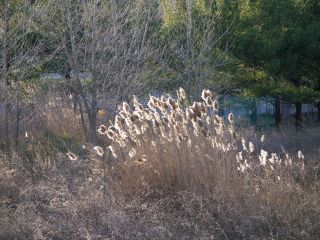December 13, 2004
Of Reeds, Thorns and Staples

FINALLY, you see above a photo taken with my new camera. Frankly , I don't find this particular picture a vast improvement. It's the close-ups that really reveal the difference, that is, when I can manage one that's in focus.
My $10 manual arrived today. The print is soooo weeny that a person with normal vision would be unable to read it. Fortunately, I am so nearsighted that I can decipher much of what's important. And, irony of ironies, I impaled my middle finger on the infamous staple , while putting the manual back into the envelope. I thought I'd pump that for some symbolic meaning, as follows:
Excerpt from Chapter V, Classes of Fairy Tales at Sacred Texts
"Sleeping Beauty , which is another romantic tale that might claim to be the most popular fairy tale, has for its theme the long sleep of winter and the awakening of spring. The Earth goddess, pricked by winter's dart, falls into a deep sleep from which she is awakened by the Sun who searches far for her. This tale is similar to the Norse Balder and the Greek Persephone . Some of its incidents appear also in The Two Brothers , an Egyptian tale of the Nineteenth Dynasty of Seti II, in which the Hathors who pronounce the fate of the Prince correspond to the wicked old Fairy. The spindle whose prick caused slumber is the arrow that wounded Achilles, the thorn which pricked Siegfried , the mistletoe which wounded Balder, and the poisoned nail of the demon in Surya Bai . In the northern form of the story we find the ivy , which is the one plant that can endure winter's touch. The theme of the long sleep occurs in the mediaeval legend of The Seven Sleepers of Ephesus , in the English The King of England and His Three Sons, poetically as Tennyson has given it in his Day-Dream , and in the Story of Brunhilde , in Siegfried. Here a hedge of flames encircles Brunhilde who is awakened at the touch of Siegfried's magic sword, just as Sleeping Beauty is awakened by the Prince's kiss. The kiss may be a survival of an ancient form of worship of some local goddess. In the Hindu Panch-Rhul Ranee, seven ditches surmounted by seven hedges of spears, surround the heroine. Of the Perrault and Grimm versions of Sleeping Beauty, the Perrault version is long and complex because it contains the minor tale of the cruel stepmother added to the main tale, while the Grimm Briar Rose is a model of structure easily separated into ten leading episodes. Sleeping Beauty appeared in Basile's Pentamerone where there is given the beautiful incident of the baby sucking the spike of flax out of its sleeping mother's fingers. The Perrault version agrees with that of Basile in naming the twins, who are Sun and Moon in the Pentamerone, Day and Dawn."
This is not to mention Androcles and his lion, or all the thorn pricks in Muslim texts which appeared when googled. I could use a little deep sleep , but not a hundred years of it. And the awakening --now there's something to look forward to.
Photo note: It took me most of my blog time to find out the name of these reeds-- Phragmites australis . Like purple loosestrife they are beautiful, ubiquitious, and, because of their invasive nature, considered an ecological threat.
Posted by Dakota at December 13, 2004 05:25 PM